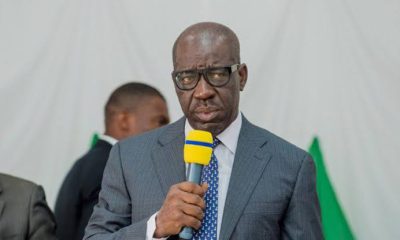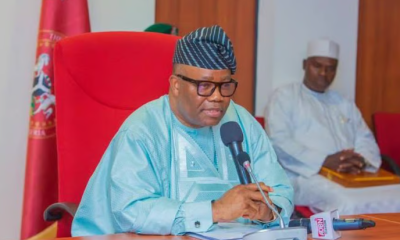Comments and Issues
As British tightens immigration law
Published
11 months agoon

Followers of news, events, information and development from the United Kingdom would have noticed that the hottest topic on the lips of most British politicians and bureaucrats is immigration.
Immigration is a big issue in Great Britain given their peculiar and unique circumstances regarding the sudden upsurge in the number of irregular migrants that pour into Great Britain through the dangerous canals connecting Britain through France. Besides, border security and affiliated issues are key to defining the sovereign authority of a nation state.
In view of the aforementioned background information, I perfectly understand and appreciate the fact that the British government has an obligation to control the levels of migration into their Country given the increasing rates of costs of living and the economic crises that were thrown up by COVID-19 pandemic that slowed down the economic fortunes of many nations. Controlling migration also addresses the critical questions associated with national security and wellbeing of a nation.
But the British people and their government do also understand that they need to balance their fears for massive irregular migration into their jurisdiction from all kinds of places but most especially from the middle East and Far East, and to realise that as an advanced economy and a good member of the international community, that prosperous nation of Great Britain owe refugees the duty of care and security in a World that has become increasingly terrorised by wars, famines, economic brigandage, political upheavals and dictatorships.
Specifically, the 1951 Refugee Convention and its 1967 Protocol are the key legal documents that form the basis of UNHCR’s work.
They define the term ‘refugee’ and outline their rights and the international standards of treatment for their protection.
Refugees are among the most vulnerable people in the world. The 1951 Refugee Convention, supplemented by its 1967 Protocol, help protect them.
They are the cornerstone of refugee protection and the key legal documents that form the basis of UNHCR’s work.
The 1951 Convention provides the internationally recognized definition of a refugee and outlines the legal protection, rights and assistance a refugee is entitled to receive.
UNHCR serves as the ‘guardian’ of these documents. We also help governments translate them into national laws to ensure refugees are protected and can excise their rights.
Core principles
The core principle of the 1951 Convention is non-refoulement, which asserts that a refugee should not be returned to a country where they face serious threats to their life or freedom.
The document outlines the basic minimum standards for the treatment of refugees, including the right to housing, work and education while displaced so they can lead a dignified and independent life. It also defines a refugee’s obligations to host countries and specifies certain categories of people, such as war criminals, who do not qualify for refugee status.
In addition, it details the legal obligations of the States that are party to one or both of these instruments.
History of the 1951 Convention
In the aftermath of the First World War (1914 – 1918), millions of people fled their homelands in search of refuge. Governments responded by drawing up a set of international agreements to provide travel documents for these people who were, effectively, the first recognized refugees of the 20th century. Their numbers increased dramatically during and after the Second World War (1939-1945), as millions more were forcibly displaced.
In response, the international community steadily assembled a set of guidelines, laws and conventions aimed at protecting the basic human rights and treatment of people forced to flee conflict and persecution.
The process, which began under the League of Nations in 1921, culminated in the 1951 Convention which consolidated and expanded on previous international instruments relating to refugees and continues to provide the most comprehensive codification of the rights of refugees at the international level.
Common questions
What is the difference between the 1951 Convention and its 1967 Protocol?
Which countries are party to the 1951 Convention and its 1967 Protocol?
What is the definition of a refugee?
Why do refugees need protection?
What rights do refugees have under the 1951 Convention?
Does a refugee also have obligations?
Can someone be excluded from refugee protection?
How can States sign on to the 1951 Convention and its 1967 Protocol?
Key documents and decisions
1951 Conference of Plenipotentiaries on the Status of Refugees and Stateless Persons (Travaux préparatoires)
Records of the 1951 Conference of Plenipotentiaries on the Status of Refugees and Stateless Persons.
The Refugee Convention, 1951: The Travaux préparatoires analysed with a Commentary by Dr. Paul Weis
1990
Conference of Plenipotentiaries on the Status of Refugees and Stateless Persons: Summary Record of the Thirty-fifth Meeting
03 December 1951
Conference of Plenipotentiaries on the Status of Refugees and Stateless Persons: Summary Record of the Thirty-second Meeting
30 November 1951
States parties, reservations and declarations
View the list of States that have acceded to one or both the 1951 Convention and its Protocol.
1951 Refugee Convention Relating to the Status of RefugeesLink is external
1967 Protocol Relating to the Status of Refugees. (UNHCR global website).
Having exhausted the global legal dimension of the obligations of nations towards genuine refugees, it is appropriate to recall vividly that during my most recent vacation in Great Britain this June, i read in some of their vibrant British press that the British premier Rishi Sunak had set a new goal of bringing migration down below the level he “inherited”, which was about 500,000 net arrivals a year when he became prime minister. Mind you, Rishi Sunak is an immigrant from India.
That was withstanding that the current Prime minister has a history of migration into Britain, but as the head of government foisted with the urgency of the now to confront their biggest threats to their very existence and survival as a sovereign nation, the PM has reportedly redefined his target on immigration after earlier in the first week of June backing away from the Conservatives’ 2019 manifesto promise to reduce it below the level then of about 220,000.
Sunak said he would not put a number on the level of net immigration he would like to see but he wanted it to come down below what it was when he took over. Figures released in November show net immigration was 500,000 for the year to June 2022.
Experts believe net immigration figures for this year could come in at between 600,000 and 1 million, prompting a backlash among Conservative backbenchers.
Speaking to broadcasters at the G7 summit in Hiroshima, Sunak said he was “crystal clear” he wanted to reduce immigration, but when pressed on how far, he said: “I’m not going to put a precise figure on it but I do want to bring them down.”
He said: “The numbers are too high and we want to bring them down. Now, the numbers last year were impacted by the fact that we welcomed Ukrainian refugees to the UK. Again, that’s something I think we are proud of.”
Asked by Sky News whether he could bring down net immigration to below 500,000 by the next election, he said: “I’m committed to bringing down the levels of migration that I inherited, and I’m relentlessly focused on stopping the boats, that’s one of my five priorities, and we’re doing absolutely everything we can to do that.”
Sunak has repeatedly said he wants to bring down levels of net immigration but also defended the system of legal migration to the UK.
“When it comes to legal migration, the key thing for people to know is we’re in control of why people are here, the circumstances and the terms on which they are here, making sure they contribute, to public services like the NHS, for example. Those are all now part of our migration system and they weren’t before,” he said.
The prime minister stressed that the difficult task of stopping “illegal” migration in small boats across the Channel was a bigger priority. “I do think most people’s number one priority when it comes to migration is illegal migration, that is crystal clear to me,” he said.
Sunak’s redefinition of the Conservatives’ aims on immigration put him at odds with the home secretary, Suella Braverman, and many on the right of the Tories.
Braverman said at the National Conservatism conference this week that the party should honour its 2019 manifesto commitment to bring down net immigration, which was then at about 225,000.
Adam Holloway, a Conservative backbencher, told GB News on Thursday: “It’s completely insane. I mean, who would have thought that a Conservative government would be drawing millions more people into the high-rate tax bracket? Who would think that a Conservative government was presiding over effectively uncontrolled immigration?”
I will discuss briefly why this law needs to be an issue for us in Nigeria given that we have a very large population in Great Britain today and of course many more Nigerians, if given the opportunities, will lawfully like to resettle in Great Britain. So we are as concerned about this latest legal jurisprudence on migration in Britain as much as the British natives so scared about the possibility of losing their native lands to strangers from far flung nations which is a distant possibility unless their government is dysfunctional. It is indeed an issue so dear to our hearts because of the historical links between our people and the British dating back to hundreds of years. In addition, many Nigerians have natural citizenship status of that nation even as many are attending different educational institutions. Corollary, Nigerians were also barred recently from bringing their relatives whilst schooling in British schools contrary to what has always been the cade in the past. So you can see that Nigerians have double issues to be concerned about the reviewed migration laws in Great Britain. So a detailed understanding of these new approaches to migration by Great Britain is critical.
But first, from a lay man’s perspective, I have asked myself what indeed are the main areas of interest in this new body of laws and policies around migration in Great Britain. We will read from the mouth of the masters who evolved the new sets of legal framework and policies.
Around March 2023, the British press were agog with confirmation that the Prime Minister Rishi Sunak and Home Secretary Suella Braverman have confirmed the Illegal Migration Bill which is causing a huge debate – but what exactly is it and what does it mean for the UK?
Rishi Sunak promised the UK he would tackle illegal immigrants when he became prime minister and his latest immigration and asylum seeker laws are his attempt at just that.
The PM, and Home Secretary Suella Braverman, confirmed in the House of Commons this week their new bill which will see people who arrive in the UK illegally removed “within weeks” and receive a lifetime ban on claiming asylum.
Causing much debate, with the UN refugee body saying they have huge concerns for the new bill, Rishi Sunak has said he’s “up for the fight” and these “tough measures” were the only way to tackle the migrant crisis and to stop unsafe boats crossing the Channel.
He said: “All I can say is that we have tried it every other way and it has not worked. So I say again: my policy is very simple, it is this country—and your government—who should decide who comes here, not criminal gangs.”
What is Rishi Sunak’s Illegal Migration Bill?
Essentially, the new law, also nicknamed ‘Stop the Boats’ wants to end illegal entry, especially via boats, as a route to asylum in the UK.
The main points of the new bill are:
People who arrive in the UK illegally will be detained and removed within weeks of arrival. If safe, they will go back to their home country, if not, they will go to a safe third country.
Under 18’s who arrive unaccompanied and illegally will remain in the UK until adulthood and will then be removed to a safe third country. Limited circumstances could change this.
Asylum seekers who enter the UK illegally will not only be removed, but also face a permanent ban from returning.
Any asylum claims from those who travel to the UK illegally will be deemed inadmissible and reconsidered in a third country.
Any legal claims that can prevent someone being removed from the UK will be limited.
Modern slavery claims for those travelling illegally will be disqualified.
There will be an annual cap on the number of refugees entering via safe routes.
What have people said about Rishi Sunak’s new immigration bill?
The tough new bill hasn’t come without criticism, as the United Nations High Commissioner for Refugees has stepped forward to say it’s concerning.
Vicky Tennant, of the UNHCR, said: “We’re very concerned. This is effectively closing off access to asylum in the UK for people arriving irregularly.
“We believe it’s a clear breach of the Refugee Convention, and remember even people with very compelling claims will simply not have the opportunity to put these forward.”
Labour’s shadow home secretary Yvette Cooper branded the Bill a “con” and described the plans as “Groundhog Day” in the wake of criticism from campaigners who said the proposed policy would be unworkable.
My recommendation is that Nigerians need to endeavour to read and apprehend the import and Far reaching implications of this new set of immigration laws in Great Britain so as to be properly guided to be on the side of the law.
*EMMANUEL ONWUBIKO is head of the HUMAN RIGHTS WRITERS ASSOCIATION OF NIGERIA and was NATIONAL COMMISSIONER OF THE NATIONAL HUMAN RIGHTS COMMISSION OF NIGERIA.
Trending

 Inspirational1 week ago
Inspirational1 week agoPastor Chris Oyakhilome: A Healing Minister Dedicated to Enhancing Public Health

 Featured6 days ago
Featured6 days agoGov, Abiodun appoints Chess master, Onakoya sports ambassador

 Crime7 days ago
Crime7 days agoVandalism: Osun water corporation appeals to residents

 Featured7 days ago
Featured7 days agoOsun PDP chieftain, Abbas resigned from party

 Business5 days ago
Business5 days agoZenith Bank shareholders approve Holdco structure

 Editorial3 days ago
Editorial3 days agoGovernor Obaseki Increases Minimum Wage to N70,000 in Edo State

 Business2 days ago
Business2 days agoNNPC says fuel queues to be cleared by Wednesday

 Featured2 days ago
Featured2 days agoNigeria confronted with multifaceted challenges – Akpabio

